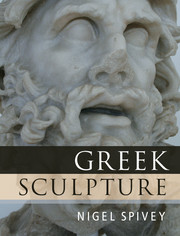Book contents
- Frontmatter
- Dedication
- Contents
- List Of Figures
- Preface
- Note
- 1 Introduction: the Study Of Greek Sculpture
- 2 The Greek Revolution
- 3 Daedalus and the Wings of Technê
- 4 Anathêmata: Gifts for the Gods
- 5 Heroes Apparent
- 6 Temple Stories
- 7 In Search of Pheidias
- 8 Revealing Aphrodite
- 9 Royal Patronage
- 10 Portraits and Personifications
- 11 Graecia Capta
- 12 Afterlife
- Index
3 - Daedalus and the Wings of Technê
Published online by Cambridge University Press: 01 December 2014
- Frontmatter
- Dedication
- Contents
- List Of Figures
- Preface
- Note
- 1 Introduction: the Study Of Greek Sculpture
- 2 The Greek Revolution
- 3 Daedalus and the Wings of Technê
- 4 Anathêmata: Gifts for the Gods
- 5 Heroes Apparent
- 6 Temple Stories
- 7 In Search of Pheidias
- 8 Revealing Aphrodite
- 9 Royal Patronage
- 10 Portraits and Personifications
- 11 Graecia Capta
- 12 Afterlife
- Index
Summary
The vocabulary of procreation is much favoured by Classical art historians and archaeologists. Many accounts of Greek art are framed in terms of ‘seeds’ being ‘sown’, techniques ‘hatched’ or ‘conceived’, forms ‘born’ and so on. But to anyone surveying the various accounts of the ‘birth’ of Greek art, the genesismetaphor must soon lose its usefulness: for the claimed parentage turns out to be less a matter of forensic certainty and more to do with political correctness or partisan bias. Thus Turkish authorities will claim ancient Anatolia as an indispensable supplier of motifs, monsters and other decorative devices; Jewish scholars may be inclined to stress the role of the Phoenicians, and not only as commercial transmitters of Eastern objects; Egyptologists insist that only a knowledge of ‘the Egyptian canon’ and Egyptian stone-cutting methods could have enabled the Greeks to have progressed from figurines to monumental statues; while staunch philhellenes will argue that Cycladic, Minoan and Mycenaean sites yield all the necessary precedents and prototypes for the figurative styles we now generally salute as ‘Greek’.
What is at stake here? In the over-arching narrative of Western art history, it is the origin of an artistic tradition that runs from Classical antiquity to our own time: a hiatus from Byzantium to the late Middle Ages, then ‘rebirth’ with the European Renaissance and thence an unbroken artistic-academic flow of inherited ideals to modernity. (It does not matter if there have been periods of revolt and reaction against ‘the Classical’ – the fixed point of absolute ‘perfection’ is still there.) According to this narrative, the ‘great names’ of art history – including, say, Leonardo, Michelangelo, Titian, Velazquez, Delacroix, Manet, Cézanne, Picasso – essentially built their work upon an awareness of what had been achieved by artists in ancient Greece – even if the work of those artists (such as the fourth-century painter Apelles) has disappeared, and even if (in the case of Cézanne and Picasso, at least) an awareness of non-Western and prehistoric art was also there.
So it becomes a loaded question – to ask, how did it start? But the very attempt to locate a time and place for the ‘genesis’ of Greek art is probably a misguided effort.
- Type
- Chapter
- Information
- Greek Sculpture , pp. 54 - 85Publisher: Cambridge University PressPrint publication year: 2013



